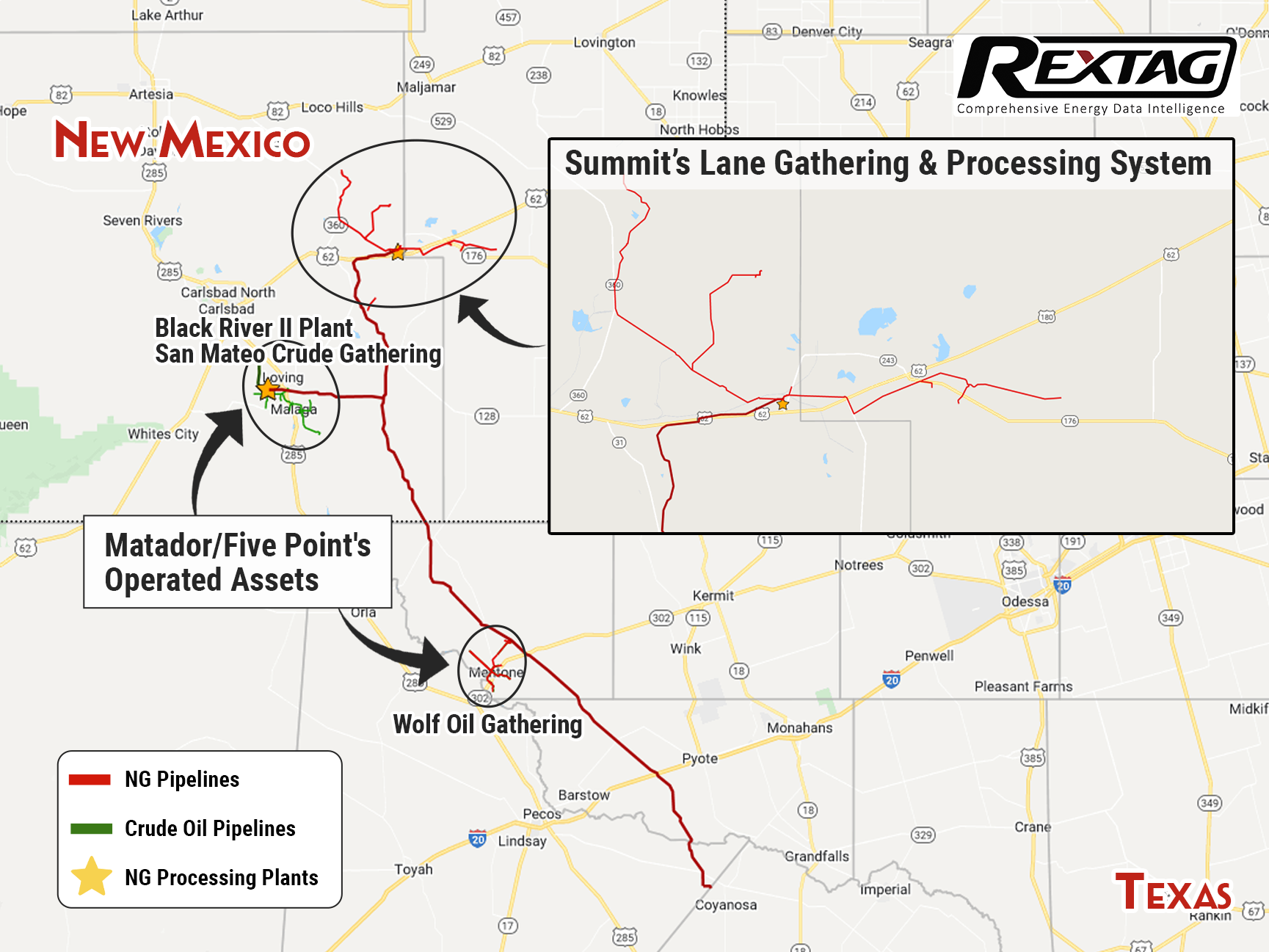Comprehensive Energy Data Intelligence
Information About Energy Companies, Their Assets, Market Deals, Industry Documents and More...
In Matador's Favor, For $75 Million Summit Sells Its Permian Midstream Assets
06/15/2022
Matador Resources Co. acquires a gathering and processing system for $75 million in New Mexico’s Eddy and Lea counties from Summit Midstream Partners LP, filling up Matador’s midstream portfolio in the Permian Basin.
According to the company release, this purchase is a logical extension of their strategy to keep their midstream operations and assets in control in order to hasten and assist their operations.
Matador reached an agreement with a subsidiary of Summit to gain Summit’s Lane Gathering and Processing System on June 9. In connection with the transaction, the company will also appropriate a certain takeaway capacity on the Double E Pipeline, a FERC-regulated natural gas pipeline operated by Summit.
Nowadays, the Lane G&P System combines a 60 MMcf/d cryogenic natural gas processing plant, three compressor stations, and about 45 miles of natural gas gathering pipelines. It is expected that the company will enlarge the Lane G&P System to help Matador’s environmental, safety, exploration, and production efforts in northern Eddy and Lea counties located within the Delaware Basin.
Gathering and processing services on the Lane G&P System are provided under long-term, fee-based gathering agreements with producers that are primarily targeting crude oil production from the Bone Spring and Wolfcamp shale formations.
As an investor presentation says, Matador began its initial midstream build-out in the Delaware Basin in 2015-2016. Since then the company has extended its midstream footprint in the Delaware using the San Mateo I and San Mateo II joint venture partnerships with Five Point Energy LLC.
Serving as the primary midstream solution for Matador, San Mateo provides midstream services to other E&P operators in the Delaware Basin. It owns and operates oil, natural gas, and produced water gathering and transportation systems in Eddy County, N.M., and Loving County, Texas, the Black River Processing Plant in Eddy County with a designed inlet capacity of 460 MMcf/d of natural gas and 13 commercial saltwater disposal wells in Eddy County and Loving County with a combined designed disposal capacity of 335,000 bbl/d.
This acquisition of additional takeaway from the Delaware Basin is also made to ensure Matador’s and third-party customers’ natural gas is transported to market. The company notices the diligence of all sides in negotiating the transaction and looks forward to closing later this month.
If you are looking for more information about energy companies, their assets, and energy deals, please, contact our sales office mapping@hartenergy.com, Tel. 619-349-4970 or SCHEDULE A DEMO to learn how Rextag can help you leverage energy data for your business.
What's Behind the Rise in U.S. Drilling Rigs?
![$data['article']['post_image_alt']](https://images2.rextag.com/public/blog/293_Blog_ What's Behind the Rise in U.S. Drilling Rigs_.jpg)
The total number of drilling rigs actively exploring and producing oil and natural gas in the United States increased to 585 for the week ending July 5, up from 581 the previous week. Despite this recent uptick, the current count still falls short of last year's 680, indicating a slowdown in drilling activities. Analysts suggest that this reduction may reflect greater efficiency among shale producers, who now require fewer rigs. Nonetheless, concerns remain about whether some producers have enough viable drilling land
Diamondback's Viper Energy Acquires $1 Billion in Royalty Interests in the Permian Basin
![$data['article']['post_image_alt']](https://images2.rextag.com/public/blog/186Blog_Viper Energy Secures $1 Billion in Permian.png)
Viper Energy's deal, comprised of cash and equity, secures an additional 2,800 net royalty acres in the Midland Basin and 1,800 in the Delaware Basin. Viper Energy Partners LP, a Diamondback Energy Inc. subsidiary, has inked a deal to acquire mineral and royalty interests in the Permian Basin. The deal, valued at around $1 billion, is with Warwick Capital Partners and GRP Energy Capital. Viper was established by Diamondback with the purpose of owning, purchasing, and capitalizing on oil and natural gas assets in North America, specifically targeting mineral and royalty interests.
![$data['article']['post_image_alt']](https://images2.rextag.com/public/blog/328_Blog_Why Are Oil Giants Backing Away from Green Energy Exxon Mobil, BP, Shell and more .jpg)
As world leaders gather at the COP29 climate summit, a surprising trend is emerging: some of the biggest oil companies are scaling back their renewable energy efforts. Why? The answer is simple—profits. Fossil fuels deliver higher returns than renewables, reshaping priorities across the energy industry.
![$data['article']['post_image_alt']](https://images2.rextag.com/public/blog/327_Blog_Oil Market Outlook A Year of Growth but Slower Than Before.jpg)
The global oil market is full of potential but also fraught with challenges. Demand and production are climbing to impressive levels, yet prices remain surprisingly low. What’s driving these mixed signals, and what role does the U.S. play?
![$data['article']['post_image_alt']](https://images2.rextag.com/public/blog/326_Blog_USA Estimated Annual Rail CO2 Emissions 2035.jpg)
Shell overturned a landmark court order demanding it cut emissions by nearly half. Is this a victory for Big Oil or just a delay in the climate accountability movement?